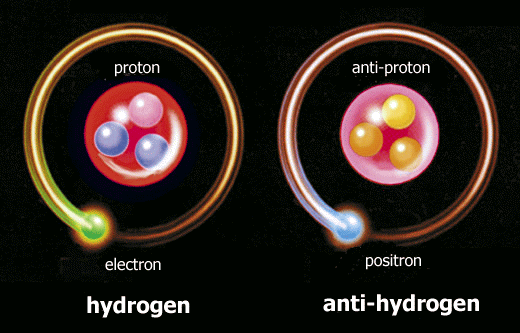In a separate technical breakthrough, also reported in Nature today, physicists at CERN used microwaves to manipulate ‘anti-matter’ atoms, once a staple of sci-fi but now one of the big frontiers of particle research. In theory, there should be equal amounts of matter and its opposite, known as anti-matter, as a result of the Big Bang that created the cosmos. But clearly there is not, otherwise the physical universe would not exist.
A window has been opened into the secret world of the anti-matter atom that might help solve one of the universe’s greatest mysteries. An international team of researchers used microwaves to manipulate atoms of “anti-hydrogen” for the first time, making them “jump”. Anti-matter is like a mirror image of ordinary matter, so electrical charges of its constituent particles are reversed.
When anti-matter and ordinary matter meet they annihilate each other in a powerful explosion as mass converts to energy. The new research from the European particle physics laboratory at Cern in Geneva, Switzerland, involved a technique called “microwave spectroscopy”. A collaboration of international scientists called Alpha confined atoms of anti-hydrogen in a magnetic trap and bombarded them with microwaves.
Scientists expect that antihydrogen will have exactly the same properties as hydrogen; but after 80 years, the test is only just becoming possible. A report in Nature has shown the first “spectra” of trapped antihydrogen, showing the energy required to change the spins of its positrons. Further experiments will show whether it is in fact just like hydrogen.
Every particle has an antiparticle, which is identical in every respect except that it has opposite charge. The negatively charged electron has the positron, and the proton has the antiproton. Together, an antiproton and a positron form the simplest anti-atom, antihydrogen. Once the anti-atom is formed, it must be kept apart from normal matter. When a particle and its antiparticle meet, they destroy each other, turning into energy in a process called annihilation.
That gets to the heart of the biggest mystery about antimatter. When the Universe formed, equal amounts of matter and antimatter should have formed; but if that were the case, they should have annihilated each other since. Recent research suggests there is a subtle difference in the way that antimatter works; and the scientists behind the new research believe their work can help probe what it is.
The feat of trapping an antihydrogen atom was first accomplished at the Antihydrogen Laser Physics Apparatus (Alpha) experiment at CERN, the European physics facility on the Franco-Swiss border that is also home to the Large Hadron Collider.
In 2010, the Alpha team reported in Nature that they trapped 38 of the atoms for a fraction of a second; and in 2011 they reported in Nature Physics that they had accomplished the trick for over 1,000 seconds. Having perfected their methods, the team has now moved on to begin analyzing the anti-atoms. “More than 20 years of research led up to this, to see if atoms of antimatter are the same as atoms of matter, and now it’s finally possible to do that,” explained Jeffrey Hangst, a scientist on Alpha.
The trick was to make use of the “magnetic moment” of the anti-atoms – the property that means they can behave somewhat like tiny bar magnets. By applying pulses of microwave energy, the team were able to make the magnets “flip”, in a process not unlike what happens to atoms in the body during an MRI scan.
“When that happens, it goes from being trapped like a marble in a bowl to being repelled, like a marble on top of a hill,” Dr Hangst explained. “It wants to ‘roll away’, and when it does that, it encounters some matter and annihilates, and we detect the fact that it disappears.”
The measurement gives the team a precise measure of how much energy it takes to accomplish that flip, but that is just the first step in what will become a longer programme of probing antihydrogen with laser light. That will show a fuller picture of the energy levels within antihydrogen.
For now, the Alpha team – whose research was recently featured in the CERN People project is satisfied with having made the first measurement on an anti-atom.
